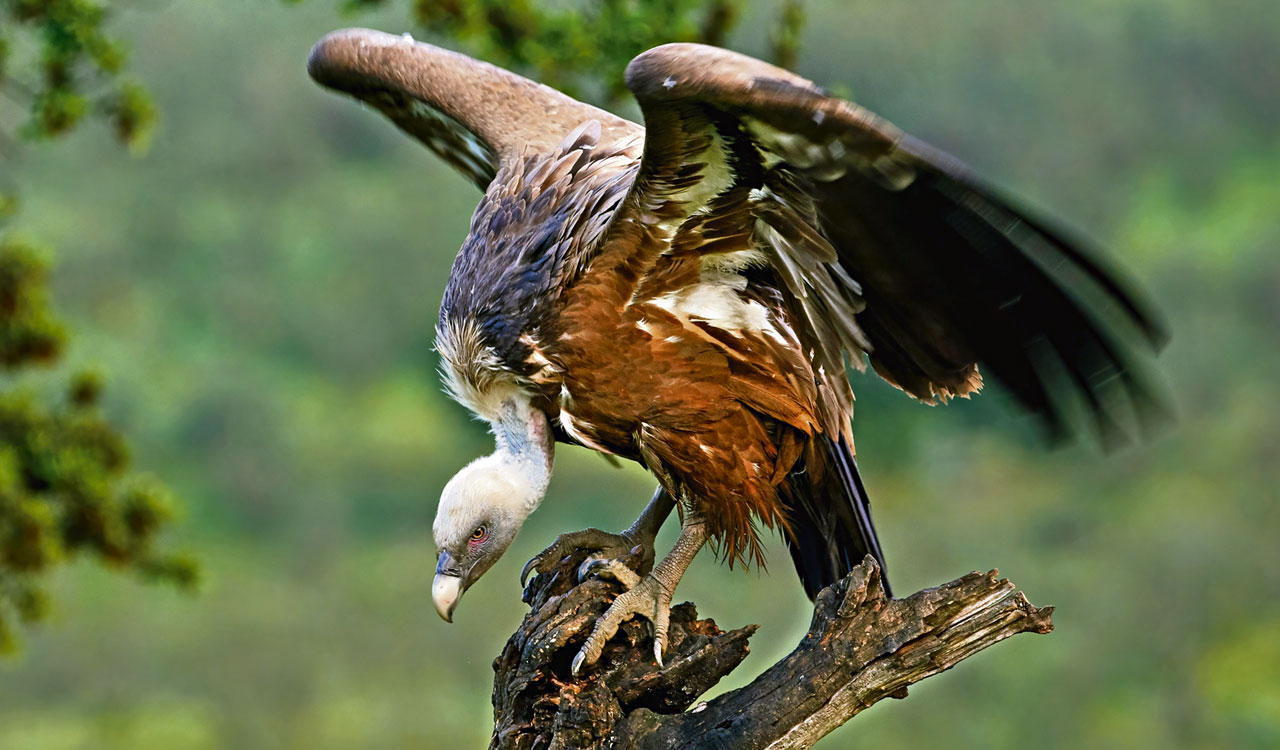Vulture conservation is a testament to the interconnectedness of ecosystem and human actions
Published Date – 12 March 2024, 11:59 PM

By Tej Singh Kardam
Throughout the ages, vultures have been revered as symbols of power and insight. The cultures of various communities throughout the world, including India, have mentioned different types of vultures which were an important being in the everyday lives of ancient people. For many, vultures may be ugly birds with a myth that they attack livestock or even human beings but the fact is, vultures are an important link in the ecosystem, feeding on the dead rotten carcasses. Our ancestors valued them and utilised their scavenging nature to dispose of the dead (humans and animals) and keep the surroundings healthy.
Vultures are large social raptors, any of 23 species of large carrion-eating birds, classified as Old World vultures; found in Asia, Europe and Africa and New World vultures, found in North, Central and South America. Most vultures have a large pouch in the throat and can go for long periods without food adaptations to a feast-or-famine scavenging lifestyle. All vultures have a gift of well-developed eyesight. Vultures are absent from Australia and most oceanic islands.
Diet, Behaviour
Most vultures are scavengers, feeding primarily on carrion – the flesh of dead animals. Their cleaning service is invaluable to humans. By hoovering up the remains of decaying bodies, they prevent stench, significantly curtail carbon emissions and eliminate bacteria like botulinum released during decomposition. Vultures have adaptations that allow them to consume rotten food that other animals can’t.
They have strong immunity to pathogens that would kill other animals. They also have strong stomach acid-1.0 pH that destroys even the most dangerous bacteria and helps them extract nutrients from their food. Vultures use their own body fluids for self-care. They exhibit Urohidrosis – the behaviour of urinating on their legs to kill the bacteria and keep cool. Old World vultures can make alarms and other calls. New World vultures have no syrinx — voice box — so they vocalise in hisses or grunts.
Decline in Population
Reduction in the vulture population is a global phenomenon of this century. Many animals depend on vultures and their role in biodiversity. Vultures are an important part of our ecosystem. The decline in vulture populations in the world, including India, may have serious consequences for ecosystems and humans alike. In Africa, several Old World Vulture species are declining due to killing, as their body parts are used in some cultures to treat physical and mental illnesses.
In India, nine species mainly of Old World Vultures have been recorded. Until the 1980s, India was home to at least 4 crore vultures. The population of three species — the Oriental white-backed, the long-billed and the slender-billed vultures — has declined by 97% since the 1990s. The prevalence of the Oriental white-backed vulture has gone down drastically by 99.9%. All three species are classified as critically endangered by the International union for the Conservation of Nature and come under Schedule 1 of the Wildlife Protection Act 1972, ie, they need the highest level of protection.
One of the main causes of the decline in the Indian vulture population is a non-steroid anti-inflammatory drug (NSAID), diclofenac. Vultures are exposed to diclofenac after feeding on the carcasses of dead farm animals. It causes kidney failure in them and hence death. In an encouraging turn of events, the Indian government banned the veterinary use of diclofenac in 2006, though the ban was poorly enforced. Other NSAIDs such as aceclofenac and ketoprofen continued to pose threats to vultures. The recent ban on these drugs heralded a significant step forward and holds promise for vulture conservation in India as the journey towards their recovery demands a unified effort to eliminate all toxic substances from the environment so that its populations have a chance to rebound. Other reasons for the decline in vulture populations are habitat degradation, food unavailability, electrocution and infectious diseases.
Unforeseen reasons such as biomagnification, contaminants like insecticides and pesticide accumulation in water bodies are potential threats, and lead to a decline in the bird”s population.
Vultures are the most efficient scavengers who can finish off the carcass of an adult animal within minutes, and keep the environment clean and prevent the outbreak of epidemics. Now with their declining numbers, accumulation of livestock carcasses may have implications on groundwater safety and livestock-borne diseases. In addition, with the availability of unused carcasses, there is an increase in the feral dog population causing serious problems for human and wild health, as dogs are carriers of rabies and distemper.
Conservation Efforts
Since it became clear that the vulture population has crashed drastically the world over and is on the verge of extinction, governments have started conservation efforts. Intensive conservation efforts taken up in Europe have shown the recovery of Egyptian, Bearded and Cinereous vultures. Similarly in North America, Californian Condor experienced a sharp decline to an extent of 22 individuals by 1982. The conservation efforts helped the species rebound over 400 and range over large areas of California, Arizona and Utah.
The Forest Department in four States of Haryana, Madhya Pradesh, West Bengal and Assam, in collaboration with the Bombay Natural History Society and the Royal Society for Protection of Birds, has established Vulture Conservation Breeding Centres. At these centres, more than 700 birds have been bred in captivity since 2004. The results are encouraging. In addition to it, the Central Zoo Authority, in collaboration with State Zoos, is setting up breeding centres at Nandankanan, Bhubaneswar; Nehru Zoological Park, Hyderabad; Muta Zoo, Ranchi, and Sakkarbagh Zoo, Junagarh. Since protected areas play a vital role in conservation, they are safe havens for vultures, offering protected spaces for breeding and nesting. It is, therefore, necessary to provide safe food sources for vultures and create conducive habitats for breeding and nesting.
Vulture conservation is a testament to the interconnectedness of ecosystems and human actions. The decline of vultures serves as a warning about unintended consequences of certain practices. Conversely, vulture recovery can serve as a beacon of hope, illustrating the positive outcomes of collective conservation actions. Let us all redouble our efforts to protect these magnificent birds and ensure that skies remain graced by the presence of vultures for generations to come.





